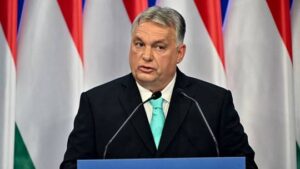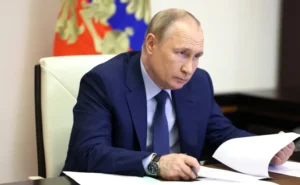Peace Shuttle: The Big Picture Behind ‘Viktor the Mediator’
CONFLICT RESOLUTION - MEDIATION, 15 Jul 2024
Pepe Escobar | Strategic Culture Foundation – TRANSCEND Media Service
The Big Picture remains: the future of the “rules-based international order” is being decided in the black soil of Novorossiya.
9 Jul 2024 – Viktor Orban is on a roll.
And that has set out a riotous roller coaster.
Everyone has been gripped by the extraordinary spectacle of pre-historic specimens wallowing in the Western geopolitical swamp reaching the depths of Hysteriastan at the sight of the Hungarian Prime Minister’s peace shuttle moving from Ukraine and Russia to China.
And to do that on the eve of the 75th anniversary of warmongering Global Robocop NATO has got to be the ultimate affront.
The 3-hour long Putin-Viktor The Mediator meeting in Moscow was quite something. These are arguably Putin’s three main points:
- Kiev cannot allow the idea of a ceasefire because that would remove the pretext for extending martial law.
- If Kiev ends martial law, it will need to hold presidential elections. The chances of the current Ukrainian authorities winning are close to zero.
- There should not be a truce for additional Kiev weaponizing: Moscow wants a complete and final endgame.
By comparison, these are arguably Orban’s three main points:
- The positions of Russia and Ukraine are very far from each other, much needs to be done.
- The war in Ukraine has begun to have an impact on the European economy and its competitiveness (as much as the EU “leadership” may deny it).
- “I heard what Putin thinks about the existing peace initiatives, the ceasefire and negotiations, and the vision of Europe after the war.”
Orban also made a point of emphasizing the airtight pre-meeting secrecy, as “means of communication are under total surveillance by the Big Boys”.
He described the search for a solution in Ukraine as his “Christian duty”. And he said he asked three direct questions to Putin: whether peace talks are possible; whether a ceasefire before they begin is realistic; and what Europe’s security architecture could look like.
Putin, said Orban, answered all three.
The clincher – not for the warmongers, but for the Global Majority – was Orban’s description of Putin:
“All negotiations with him, he is always in a good mood – this is the first thing. Secondly, he is more than 100% rational. When he negotiates, when he begins to explain, when he makes an offer, saying yes or no, he is super, super rational. How else can you say it in Hungarian? Cool headed, reserved, careful and punctual. He has discipline. So it is a real challenge to negotiate with him and be prepared to match his intellectual and political level.”
That new Eurasia security system
All of the above ties up with the concept of a new Eurasia security system proposed last month by Putin – and a key theme of discussion at the Shanghai Cooperation Organization (SCO) summit in Astana last week.
Putin has emphasized the central role of the SCO in the process, stating that a “decision was made to turn the SCO regional anti-terrorist structure into a universal center tasked with responding to the entire range of security threats.”
In a nutshell: the SCO will be arguably the key node in the new Eurasia-wide indivisibility of security arrangement. This is as huge as it gets.
It all started with the concept of Greater Eurasian Partnership, proposed by Putin in 2015 and conceptualized by Sergey Karaganov in 2018. Putin took it to another level in his meeting with key Russian diplomats in June; it’s time to set up serious bilateral and multilateral guarantees for collective Eurasian security.
That should be a security architecture, according to Putin, open to
“all Eurasian countries that wish to participate,” including “European and NATO countries.”
And it should lead to “gradually phasing out” the military presence of “external powers in Eurasia”, side by side with “establishing alternatives to Western-controlled economic mechanisms, expanding the use of national currencies in settlements, and establishing independent payment systems.”
In a nutshell: a complete geopolitical and technical-military revamp, as well as geoeconomic (the importance of developing alternative international transport corridors such as the INSTC).
The Chargé d’Affaires of the Russian Mission to the EU, Kirill Logvinov, tried to brief the Europeans last week, under the rubric “New Security Architecture for the Eurasian Continent”.
Logvinov explained how “the Euro-Atlantic concept of security has collapsed. Based on U.S. and NATO dominance, the European regional security framework has failed to ensure the practical implementation of the ‘indivisible security for all’ principle.”
A future system of security and cooperation in Eurasia will then form the “foundation of the global security architecture in a multipolar world based on the UN Charter principles and the rule of international law.”
And the Greater Eurasian Partnership will form the economic and social basis of this new Eurasian security system.
Hell will freeze over before the EU/NATO accept the new reality. But the fact is the already emerging mutual security space within the SCO should make Eurasia – minus its Western Europe peninsula, at least for the foreseeable future – more solid in terms of Big Power strategic stability.
Eventually, it will be up to Europe – rather Far Western Eurasia: either you remain as lowly vassals under the declining Hegemon, or you Look East for a sovereign, dynamic future.
The Russian plan v. all other plans
It’s under this Big Picture that Putin’s peace plan for Ukraine – announced on June 14 in front of the crème de la crème of Russian diplomats – should be understood. Orban certainly got it.
Any other plans – with the exception of the revised Chinese offer, and that’s why Orban went to Beijing – are irrelevant, from Moscow’s perspective.
Of course Team Trump had to come up with their own NATO-centered plan. That’s not exactly a gift to clueless Europeans.
Under Trump, NATO’s role will shift: it will become an “auxiliary” force in Europe. Washington of course will keep its nodes in the Empire of Bases – in Germany, UK, Turkey – but ground forces, armored vehicles, artillery, logistics, everything, high costs included, will be fully paid by wobbling European economies.
Under the coordination of Trump’s national defense strategy adviser, Elbridge Colby, the new administration would promise to give Putin commitments “not to expand NATO to the east.” Moreover, Trump seems to be ready to “consider territorial concessions” to Russia.
As if Moscow would be praying in unison to get “concessions” from a notoriously unreliable American president.
The whole point of this plan is that under Trump 2.0 the main “threat” to the U.S. will be China, not Russia.
With only four months before the U.S. presidential election, and with the cadaver in the White House at the point of being thrown – especially by powerful donors – under the (retirement home) bus, it finally dawned even on the zombie crowd that the dream of inflicting a strategic defeat on Russia is over.
Still, the Dems in D.C. and their discombobulated NATO vassals are desperate to impose a Korean scenario: a sham ceasefire and a freeze along the current frontlines.
In this case hell will freeze over before Moscow accepts a “peace plan” that preserves the possibility of a somewhat rump Ukraine entering NATO and the EU in the near future, plus preserving a re-weaponized Ukrainian army on Russia’s western front.
A freeze of the war now translates as a new war in two or three years with a hugely re-weaponized Kiev. That’s not gonna happen – as Moscow’s absolute imperative is a neutral Ukraine, fully de-militarized, plus the end of the official de-Russification juggernaut.
Orban arguably is not playing the NATO game of trying to “persuade” Russia – and China – to a truce, with Beijing putting pressure on Moscow. Unlike his clueless EU partners, Orban may have learned a thing or two about the Russia-China strategic partnership.
The next four months will be frantic, both on the negotiation and the crypto-negotiation fronts. The war likely will not end in 2024. And the scenario of a long, dreadful multi-year war may – and the operative word is “may” – only be dispelled with Trump 2.0: and that, over the Deep State’s collective dead bodies.
The Big Picture remains: the future of the “rules-based international order” is being decided in the black soil of Novorossiya. It’s Unipolar Order vs. Multipolar, Multi-Nodal Order.
NATOstan is not in the position to dictate any pathetic mumbo jumbo to Russia. Putin’s offer has been the last one. Won’t take it? The war will go on all the way – until total surrender.
There are no illusions whatsoever in Moscow that the collective West may accept Putin’s offer. Sergey Naryshkin, the head of the SVR, has been blunt: the conditions will only get worse. Putin announced just the “lowest level” of Moscow’s conditions.
Orban may have understood that in real conditions for a peace settlement, the DPR, LPR, Zaporozhye and Kherson regions will come to Russia along their original administrative borders; Ukraine will be neutral, nuclear-free and non-aligned; all collective West sanctions will be lifted; and Russia’s frozen funds will be returned.
Before any of that happens – such a long shot – Russia has plenty of time. The priority now is a successful BRICS summit next October in Kazan. New presidential aides Nikolai Patrushev and A. Dyumin, along with the new Defense Minister Belousov, are honing the Big Picture strategy.
Meanwhile, there’s always the NATO show – as a side show. So peaceful, so benign, so democratic. Such cool production values. Join the fun!
_______________________________________________
 Pepe Escobar, born in Brazil, is a correspondent and editor-at-large at Asia Times and columnist for Consortium News and Strategic Culture in Moscow. Since the mid-1980s he’s lived and worked as a foreign correspondent in London, Paris, Milan, Los Angeles, Singapore, and Bangkok. He has extensively covered Pakistan, Afghanistan and Central Asia to China, Iran, Iraq and the wider Middle East. He is the author of Globalistan (2007), Red Zone Blues (2007), Obama Does Globalistan (2009), Empire of Chaos (2014) and 2030 (2015), all by Nimble Books. Pepe was contributing editor to The Empire and The Crescent and Tutto in Vendita in Italy and is also associated with the Paris-based European Academy of Geopolitics. When not on the road he lives between Paris and Bangkok.
Pepe Escobar, born in Brazil, is a correspondent and editor-at-large at Asia Times and columnist for Consortium News and Strategic Culture in Moscow. Since the mid-1980s he’s lived and worked as a foreign correspondent in London, Paris, Milan, Los Angeles, Singapore, and Bangkok. He has extensively covered Pakistan, Afghanistan and Central Asia to China, Iran, Iraq and the wider Middle East. He is the author of Globalistan (2007), Red Zone Blues (2007), Obama Does Globalistan (2009), Empire of Chaos (2014) and 2030 (2015), all by Nimble Books. Pepe was contributing editor to The Empire and The Crescent and Tutto in Vendita in Italy and is also associated with the Paris-based European Academy of Geopolitics. When not on the road he lives between Paris and Bangkok.
Go to Original – strategic-culture.su
Tags: Conflict Mediation, European Union, Hungary, NATO, Russia, Ukraine
DISCLAIMER: The statements, views and opinions expressed in pieces republished here are solely those of the authors and do not necessarily represent those of TMS. In accordance with title 17 U.S.C. section 107, this material is distributed without profit to those who have expressed a prior interest in receiving the included information for research and educational purposes. TMS has no affiliation whatsoever with the originator of this article nor is TMS endorsed or sponsored by the originator. “GO TO ORIGINAL” links are provided as a convenience to our readers and allow for verification of authenticity. However, as originating pages are often updated by their originating host sites, the versions posted may not match the versions our readers view when clicking the “GO TO ORIGINAL” links. This site contains copyrighted material the use of which has not always been specifically authorized by the copyright owner. We are making such material available in our efforts to advance understanding of environmental, political, human rights, economic, democracy, scientific, and social justice issues, etc. We believe this constitutes a ‘fair use’ of any such copyrighted material as provided for in section 107 of the US Copyright Law. In accordance with Title 17 U.S.C. Section 107, the material on this site is distributed without profit to those who have expressed a prior interest in receiving the included information for research and educational purposes. For more information go to: http://www.law.cornell.edu/uscode/17/107.shtml. If you wish to use copyrighted material from this site for purposes of your own that go beyond ‘fair use’, you must obtain permission from the copyright owner.
Join the discussion!
We welcome debate and dissent, but personal — ad hominem — attacks (on authors, other users or any individual), abuse and defamatory language will not be tolerated. Nor will we tolerate attempts to deliberately disrupt discussions. We aim to maintain an inviting space to focus on intelligent interactions and debates.
Read more
Click here to go to the current weekly digest or pick another article:
CONFLICT RESOLUTION - MEDIATION:

